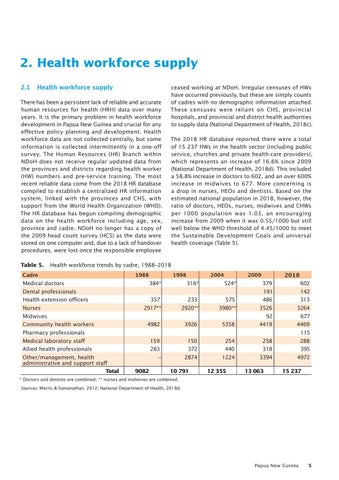2. Health workforce supply 2.1 Health workforce supply There has been a persistent lack of reliable and accurate human resources for health (HRH) data over many years. It is the primary problem in health workforce development in Papua New Guinea and crucial for any effective policy planning and development. Health workforce data are not collected centrally, but some information is collected intermittently in a one-off survey. The Human Resources (HR) Branch within NDoH does not receive regular updated data from the provinces and districts regarding health worker (HW) numbers and pre-service training. The most recent reliable data come from the 2018 HR database compiled to establish a centralized HR information system, linked with the provinces and CHS, with support from the World Health Organization (WHO). The HR database has begun compiling demographic data on the health workforce including age, sex, province and cadre. NDoH no longer has a copy of the 2009 head count survey (HCS) as the data were stored on one computer and, due to a lack of handover procedures, were lost once the responsible employee
ceased working at NDoH. Irregular censuses of HWs have occurred previously, but these are simply counts of cadres with no demographic information attached. These censuses were reliant on CHS, provincial hospitals, and provincial and district health authorities to supply data (National Department of Health, 2018c). The 2018 HR database reported there were a total of 15 237 HWs in the health sector (including public service, churches and private health-care providers), which represents an increase of 16.6% since 2009 (National Department of Health, 2018d). This included a 58.8% increase in doctors to 602, and an over 600% increase in midwives to 677. More concerning is a drop in nurses, HEOs and dentists. Based on the estimated national population in 2018, however, the ratio of doctors, HEOs, nurses, midwives and CHWs per 1000 population was 1.03, an encouraging increase from 2009 when it was 0.55/1000 but still well below the WHO threshold of 4.45/1000 to meet the Sustainable Development Goals and universal health coverage (Table 5).
Table 5. Health workforce trends by cadre, 1988–2018 Cadre
1988
Medical doctors
1998
384*
2004
316*
524*
Dental professionals Health extension officers Nurses
2018
2009
379
602
191
142
357
233
575
486
313
2917**
2920**
3980**
3526
3264
92
677
4419
4469
Midwives Community health workers
4982
3926
5358
Pharmacy professionals
115
Medical laboratory staff
159
150
254
258
288
Allied health professionals
283
372
440
318
395
–
2874
1224
3394
4972
Other/management, health administrative and support staff Total
9082
10 791
12 355
13 063
15 237
* Doctors and dentists are combined; ** nurses and midwives are combined. Sources: Morris & Somanathan, 2012; National Department of Health, 2018d.
Papua New Guinea
5

